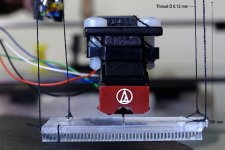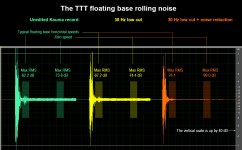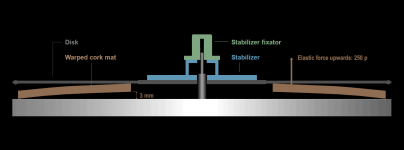Link doesn't seem to be accessible to meOne more test recording.
Le Grand Orchestre De Paul Mauriat
L'oiseau Et L'enfant
Philips 9120 222
Greece, 1977
Music Player for Google Drive
One more test recording.
Le Grand Orchestre De Paul Mauriat
L'oiseau Et L'enfant
Philips 9120 222
Greece, 1977
Music Player for Google Drive
Now I feel stupid. Finally found above recording, and it far from lives up to earlier work from 1974. Here is the album that I loved:
[URL="https://www.youtube.com/channel/UChnGpelO8OECZ3qA-GfeP8Q"]https://www.youtube.com/channel/UChnGpelO8OECZ3qA-GfeP8Q

Last edited:
Member
Joined 2019
ubergeeknz, Cuerilla,
Thank you for the information about the "Music Player for Google Drive" files. I called this type of links "experimental" in my post 143, because I suspected that they may be not accessible by others. I will use other ways to post, time by time, test recordings in high quality formats (lossless flac or best quality ogg). The music is available anyway in my YouTube channel, where the sound is in webm format and the quality, although quite high, is slightly inferior that the original one. This is a YouTube issue, not mine.
I recommend Google Drive as a reliable way to exchange music files for tests and comparisons. They provide 15 GB for free - this is a quite big storage place. Any critic of my works could upload there some recordings he/she considers of very good quality as compared with my edited ones. Everyone could listen, measure and compare. For those not familiar with Google Drive, there is a special procedure providing a link to an uploaded file - "Get Shareable Link". The shared files can be listened, but also downloaded by all.
Thank you for the information about the "Music Player for Google Drive" files. I called this type of links "experimental" in my post 143, because I suspected that they may be not accessible by others. I will use other ways to post, time by time, test recordings in high quality formats (lossless flac or best quality ogg). The music is available anyway in my YouTube channel, where the sound is in webm format and the quality, although quite high, is slightly inferior that the original one. This is a YouTube issue, not mine.
I recommend Google Drive as a reliable way to exchange music files for tests and comparisons. They provide 15 GB for free - this is a quite big storage place. Any critic of my works could upload there some recordings he/she considers of very good quality as compared with my edited ones. Everyone could listen, measure and compare. For those not familiar with Google Drive, there is a special procedure providing a link to an uploaded file - "Get Shareable Link". The shared files can be listened, but also downloaded by all.
you are right, that PKs files dont document the quality of the arm. To do that we would need a known reference and expert-widnesses to confirm that both the reference and PKs arm was set up optimally. PK is only posting files as he makes them for preservation. We could discuss if his method is sound, but that doesnt have to do with the "Floating Tangential Tonearm", so should be in another thread. PK chose to post them in this thread, and if he hadnt done it, the thread would have been more about its original topic.
Let him speak for himself what is the purpose to post these digital rips here. If I misunderstood his purpose, I would be happy to take my words back.
You keep coming back to your own air-bearing. Just remember that if someone posts a new idea to diy a tonearm- Its not an attack on your work. Reading your comments could lead one to think that you think, that all people should stop designing arms cause you already perfected tonearms to a degree that further experiments are futile.
Where did you get such an idea? Imagination? I welcome all the people come to my thread and “attack” my work. I am all ears and very happy to hear any criticisms. If you can come up with some good ideas, I will be very happy to hear. In the discussions here, I referred my air bearing arms because I can only express my opinions based upon my own experience. This is a great forum to see new ideas, to learn and to exchange ideas. Why in the world do I think other ideas are "attacks" to my work?
Sorry. But thats how it comes out. You didnt come with any ideas for improvement - or I missed it
At the beginning of this thread, I already gave him the most important suggestion. DO NOT USE WATER. The rest of his arm needs to be refined as well. However, it makes no sense to refine the arm while it is built on a problematic foundation.
Last edited:
Member
Joined 2019
Member
Joined 2019
One more test recording. An old Soviet LP with even older recordings of world orchestras, mainly Americans. From the early years of stereo.
Orchestras Parade
Мелодия С60-05855-56
USSR, 1978
Selected parts:
00:00 Enoch Light Orchestra - Warm Breath
03:39 Gerald Bandera Orchestra - Your Name
05:59 Gerald Bandera Orchestra - Leave Me
Парад Оркестров (2).flac - Google Drive
Orchestras Parade
Мелодия С60-05855-56
USSR, 1978
Selected parts:
00:00 Enoch Light Orchestra - Warm Breath
03:39 Gerald Bandera Orchestra - Your Name
05:59 Gerald Bandera Orchestra - Leave Me
Парад Оркестров (2).flac - Google Drive
In the discussions here, I referred my air bearing arms because I can only express my opinions based upon my own experience.
At least you recognize YOUR idea is not HIS idea. You ALWAYS come across as attacking people. You may not think so yourself but your tone and your wording do have an aggressive nature, at least to me, that's not really the friendliest to a hobbyist forum. Not everyone is going for perfection like you do (...and no amount of perfection in tracking will make me want to use an air pump in audio). Some people just want to experiment and have some fun, flaws and all. Sure, you always have a come back with "I just express my opinion." Yada yada yada...
At least you recognize YOUR idea is not HIS idea. You ALWAYS come across as attacking people. You may not think so yourself but your tone and your wording do have an aggressive nature, at least to me, that's not really the friendliest to a hobbyist forum. Not everyone is going for perfection like you do (...and no amount of perfection in tracking will make me want to use an air pump in audio). Some people just want to experiment and have some fun, flaws and all. Sure, you always have a come back with "I just express my opinion." Yada yada yada...
Yes. I can only express my opinions based on my own experience. Of course, my idea is NOT his idea. We all learn when different ideas meet here. I only agree or disagree with someone's ideas but NEVER ATTACKING PEOPLE. I may be too straight forward about an idea or a design, but never towards someone personally. If I did, I will be happy to correct it. Yet again, I just express my opinion about a design or an idea.
(...and no amount of perfection in tracking will make me want to use an air pump in audio).
This is perfectly fine with me. It is your own choice. But your choice doesn't deny the fact.
Last edited:
At least you recognize YOUR idea is not HIS idea. You ALWAYS come across as attacking people. You may not think so yourself but your tone and your wording do have an aggressive nature, at least to me, that's not really the friendliest to a hobbyist forum. Not everyone is going for perfection like you do (...and no amount of perfection in tracking will make me want to use an air pump in audio). Some people just want to experiment and have some fun, flaws and all. Sure, you always have a come back with "I just express my opinion." Yada yada yada...
100% agree!
Member
Joined 2019
...and no amount of perfection in tracking will make me want to use an air pump in audio.
Dear directdriver. I agree with most of what you say in post 168. But not with the opinion in the above quote. I am sure that air bearing is inherently the best possible, but I disagree with some realizations of this technics. For example:
- The quite short tonearms, forcing the tonearm rotation axis too high and resulting in considerable alterations of the effective length and the tracking angle in the case of strong warps. I posted here a special clip about this.
- The quite high values of the tonearm mass, in some cases close or even higher than 100 g.
Of all the variants I have seen so far, I would like to have and test a Bergmann tonearm:
Magne T.T. system - bergmannaudio.com
I will answer your comments briefly since this is not air bearing thread.
Check DIY linear arm thread. Niffy did a clever and out of box thinking calculation.
A good linear arm is an optimum combination of mass, friction and cartridge compliance. To single out mass doesn't mean anything.
I surely have opinions about this kind of air bearing arm. But I am not going to say it here since it is not the focus of this thread.
- The quite short tonearms, forcing the tonearm rotation axis too high and resulting in considerable alterations of the effective length and the tracking angle in the case of strong warps. I posted here a special clip about this.
Check DIY linear arm thread. Niffy did a clever and out of box thinking calculation.
- The quite high values of the tonearm mass, in some cases close or even higher than 100 g.
A good linear arm is an optimum combination of mass, friction and cartridge compliance. To single out mass doesn't mean anything.
Of all the variants I have seen so far, I would like to have and test a Bergmann tonearm:
Magne T.T. system - bergmannaudio.com
I surely have opinions about this kind of air bearing arm. But I am not going to say it here since it is not the focus of this thread.
Last edited:
Member
Joined 2019
The Eora measuring installation
The installation could be named "Pendulum", but it looks more like a hanging swing, so I baptized it "Eora" - the ancient Greek word for swing. A 20 x 40 mm Plexiglass platform hangs on 4 thin (0.12 mm) threads from about 35 cm height. The TTT stylus lays on the platform with its normal tracking force of 2 p. When displaced from the equilibrium point, the tonearm system (with mass about 30 g) returns to the equilibrium with rapidly decaying oscillations. The return is recorded and the signal of the part with horizontal velocities ≤ 1 mm/s* is analyzed. The analysis refers to the original signal and those after 2 steps of my standard editing: the cut of very low frequencies and the noise reduction. In this case as "noise" I consider the signal when the tonearm is immovable.
The lower part of Eora is shown in Att.1 . A clip with a typical cartridge return to equilibrium is shown in the Google drive link .The waveforms and the results of their analysis are shown in Att.2 . The measured noise is quite low, so the signal is up by 40 dB, in order to be well visible. All the RMS values are unweighted.
It is clear that the floating tonearm movement noise is well below the groove noise levels, which are typically higher than -55 dB, therefore it is totally masked by the groove noise and removed after the music recording noise reduction.
* 1 mm/s are the maxima in the case of 0.3 mm record eccentricity. For a perfectly centered record the horizontal tonearm velocity is typically within 0.03 - 0.12 mm/s.
Eora 3.mp4 - Google Drive
The installation could be named "Pendulum", but it looks more like a hanging swing, so I baptized it "Eora" - the ancient Greek word for swing. A 20 x 40 mm Plexiglass platform hangs on 4 thin (0.12 mm) threads from about 35 cm height. The TTT stylus lays on the platform with its normal tracking force of 2 p. When displaced from the equilibrium point, the tonearm system (with mass about 30 g) returns to the equilibrium with rapidly decaying oscillations. The return is recorded and the signal of the part with horizontal velocities ≤ 1 mm/s* is analyzed. The analysis refers to the original signal and those after 2 steps of my standard editing: the cut of very low frequencies and the noise reduction. In this case as "noise" I consider the signal when the tonearm is immovable.
The lower part of Eora is shown in Att.1 . A clip with a typical cartridge return to equilibrium is shown in the Google drive link .The waveforms and the results of their analysis are shown in Att.2 . The measured noise is quite low, so the signal is up by 40 dB, in order to be well visible. All the RMS values are unweighted.
It is clear that the floating tonearm movement noise is well below the groove noise levels, which are typically higher than -55 dB, therefore it is totally masked by the groove noise and removed after the music recording noise reduction.
* 1 mm/s are the maxima in the case of 0.3 mm record eccentricity. For a perfectly centered record the horizontal tonearm velocity is typically within 0.03 - 0.12 mm/s.
Eora 3.mp4 - Google Drive
Attachments
Last edited:
Member
Joined 2019
An warped elastic cork mat
After I glued a fabric layer to my cork mat, the result became slightly warped. The warp was 'uniform' - about 3 mm rise in the center hole. I was ready to try some way to fix it, but realized, that this form of mat may be beneficial for its better contact with the disk, after the use of the central stabilizer. This is due to the fact that the vertical force needed to overcome the mat warping is about 250 p and the pressure will be applied more uniformly across the 'mated' disk area. I use the mat this way. With the matt full down to the platter surface, naturally.
After I glued a fabric layer to my cork mat, the result became slightly warped. The warp was 'uniform' - about 3 mm rise in the center hole. I was ready to try some way to fix it, but realized, that this form of mat may be beneficial for its better contact with the disk, after the use of the central stabilizer. This is due to the fact that the vertical force needed to overcome the mat warping is about 250 p and the pressure will be applied more uniformly across the 'mated' disk area. I use the mat this way. With the matt full down to the platter surface, naturally.
Attachments
Last edited:
Member
Joined 2019
Eora pendulum 2
A quick analysis of the Eora oscillations decay (the last small movements in the video of my #173 post) indicates a tonearm horizontal friction force at the 1 mm/s velocity level well below 10 dyne. This is a nice and quite unexpected by me value, but I have to confirm and clarify it by building a better swing. The length will be 80 cm, so the pendulum period will become 1.8 sec (now it is 1.15 s), and also some weight (about 70 g) will be added, in order to have slower decay of the pendulum oscillations and better measuring possibilities. The enhanced mass will not change the friction force.
A quick analysis of the Eora oscillations decay (the last small movements in the video of my #173 post) indicates a tonearm horizontal friction force at the 1 mm/s velocity level well below 10 dyne. This is a nice and quite unexpected by me value, but I have to confirm and clarify it by building a better swing. The length will be 80 cm, so the pendulum period will become 1.8 sec (now it is 1.15 s), and also some weight (about 70 g) will be added, in order to have slower decay of the pendulum oscillations and better measuring possibilities. The enhanced mass will not change the friction force.
Last edited:
Member
Joined 2019
My Audio-visual Law
"The visibility and the audibility of the disk eccentricity results have quite similar perception levels".
In a more human language: If one can not percept visually the eccentricity of a disk (this is the case of ecc. ≤ 0.05 mm), he also can not perceptl the sound pitch alterations created by this ecc. (≤ ±0.08% in the innermost 60 mm grooves).
Well, this is rather a joke, but quite close to the truth. Some experienced musicians, singers, sound engineers etc. declare that they can clearly feel a wow of 0.1%, but most of the people can not. The requirement of the test is to be made with headphone, in order to avoid the influence of the room acoustics, which will help with it's standing waves, combined with small movements of the head.
I prepare an installation, which will help me to center as better as possible the disks without spending many time on it. It will be based on my digital microscope and a device for it's quick locating over the desired disk point. I attach a short clip of this type. It begins with an eccentricity of ≈ 0.1 mm, which is gradually and intentionally worsted up to 0.6 mm.
Digital Microscope Centering.mp4 - Google Drive
"The visibility and the audibility of the disk eccentricity results have quite similar perception levels".
In a more human language: If one can not percept visually the eccentricity of a disk (this is the case of ecc. ≤ 0.05 mm), he also can not perceptl the sound pitch alterations created by this ecc. (≤ ±0.08% in the innermost 60 mm grooves).
Well, this is rather a joke, but quite close to the truth. Some experienced musicians, singers, sound engineers etc. declare that they can clearly feel a wow of 0.1%, but most of the people can not. The requirement of the test is to be made with headphone, in order to avoid the influence of the room acoustics, which will help with it's standing waves, combined with small movements of the head.
I prepare an installation, which will help me to center as better as possible the disks without spending many time on it. It will be based on my digital microscope and a device for it's quick locating over the desired disk point. I attach a short clip of this type. It begins with an eccentricity of ≈ 0.1 mm, which is gradually and intentionally worsted up to 0.6 mm.
Digital Microscope Centering.mp4 - Google Drive
Dr. Kritidis, please clarify one thing for me. Multiple times you have used 'p' as a unit and mentioned 'pond'. In many years of engineering, audio or otherwise, I've never seen that unit used. Google searches tell me it's obsolete. I believe that one pond is one "gram-force". Is that true? I.E., when you say that your cartridge is set to '2p', do you mean that it is tracking at what the audio world calls '2 grams' (force)?
Very interesting experiments and very interesting videos. I enjoy watching the development in real time.
thanks
Very interesting experiments and very interesting videos. I enjoy watching the development in real time.
thanks
Member
Joined 2019
Dr. Kritidis, please clarify one thing for me. Multiple times you have used 'p' as a unit and mentioned 'pond'. In many years of engineering, audio or otherwise, I've never seen that unit used. Google searches tell me it's obsolete. I believe that one pond is one "gram-force". Is that true? I.E., when you say that your cartridge is set to '2p', do you mean that it is tracking at what the audio world calls '2 grams' (force)?
Very interesting experiments and very interesting videos. I enjoy watching the development in real time.
thanks
Hi. Yes, I use pond instead of gram, because to use "gram" without the addition - force to express a force is not correct. I could use the SI units instead of CGS, but I find the SI ones not quite 'natural' for the description of thinks happening in the gram and dyne regions. I get sick when see something expressed in µm/mN …
Perhaps I should use dyne always? Reminding that 1 dyne is very close to 1 mg-force? Or I should use g-force and mg-force? What is your opinion? My own is that it is better to use dyne.
Thanks for the explanation. I'm glad I was interpreting correctly. In the world of phono systems the use of 'grams' for stylus force is so engrained even though, as you say, it's really gram-force. Especially among USA readers, folks are not necessarily as familiar with metric units. I'd stick with gram-force (or even grams). Audiophiles have a notion of how much force a 'gram (-force)' is from adjusting and using their tonearms -- they can more readily have an intuitive feel for the magnitude of forces you're discussing.
- Home
- Source & Line
- Analogue Source
- Floating Tangential Tonearm


